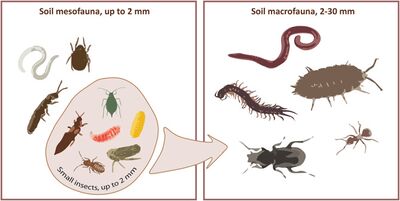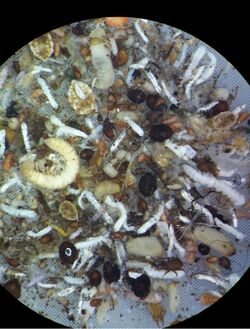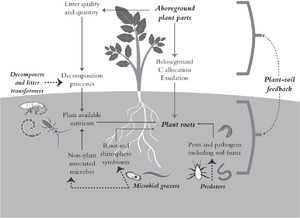Mesofauna
What Are Soil Mesofauna?


Soil mesofauna are intermediate sized animals that live in the soil [3]. These animals are between 100 micrometers and 2 millimeters in length. The organisms that make up the soil mesofauna are nematodes, mites, springtails, proturans, and pauropods [3].
Soil Mesofauna Diet
Soil mesofuana have a wide variety of diets. Although most eat decaying plant material, they also eat microorganisms, soil animals, decaying animal material, living plants, and fungi [3].
There are three types of feeders in the mesofauna: micropredators, litter ingestors, and ecosystem engineers [5].
Micropredators eat microbial biomass while also controlling the microbial population. In this process, the micropredators release nutrients into the soil from the microbial biomass that they eat [5].
Litter ingestors eat leaf litter that have fallen off of the trees and shrubbery. These mesofauna modify the chemical composition as well as the physical structure of the soil [5].
Ecosystem engineers burrow and ingest the soil they live in, and modify the overall soil structure [5]. This includes mesofauna such as earthworms.
Soil Mesofauna Habitat and Populations
Soil mesofauna are found in the soil of all continents. They live on the surface of soil, the epigeic layer, and the lower soil profiles. In most agricultural soils, most activity happens 4-8 inches below the soil [6].
In different habitats, soil mesofauna populations vary based on soil type, soil compaction, temperature, precipitation, and moisture in the environment [6]. Mesofauna are very sensitive to changes in the environment, so population will drastically fluctuate time and time again [2]. The mesofauna are most abundant in the spring and fall due to mild temperatures and moistness in the soil. Populations of mesofauna will decrease if the pH and organic matter also decrease [2].
Soil Mesofauna Effect On Soil
Soil mesofauna eat roots in the soil and open drainage and aeration channels [5]. These channels contain fecal material that can be broken down and ingested by smaller organisms.
Soil mesofauna are capable of suppressing and transmitting plant pathogens in the environment as well as allocating plant nutrient allocation and growth. They are capable of seed germination as well [6].

Citations
[1] Gongalsky, K. B. (2021). Soil Macrofauna: Study Problems and Perspectives. Soil Biology and Biochemistry, 159, 108281. doi:10.1016/j.soilbio.2021.108281
[2] Kusumastuti, A., Indrawati, W., Dewi, R., & Kurniawan, A. (2022). Mesofauna abundance and soil properties in various soil améliorants and percentage of urea fertilizer dosage in Sugar Cane Plantation. IOP Conference Series: Earth and Environmental Science, 1012(1), 012054. doi:10.1088/1755-1315/1012/1/012054
[3] Mesofauna. (n.d.). Retrieved May 10, 2022, from https://www.britannica.com/science/mesofauna
[4] Nielsen, U. (2019). Functional Roles of Soil Fauna. In Soil Fauna Assemblages: Global to Local Scales (Ecology, Biodiversity and Conservation, pp. 42-85). Cambridge: Cambridge University Press. doi:10.1017/9781108123518.003
[5] Potapov, A. M., Beaulieu, F., Birkhofer, K., Bluhm, S. L., Degtyarev, M. I., Devetter, M., . . . Scheu, S. (2022). Feeding habits and multifunctional classification of soil‐associated consumers from protists to vertebrates. Biological Reviews, 97(3), 1057-1117. doi:10.1111/brv.12832
[6] Soil mesofauna - cpb-us-e1.wpmucdn.com. (n.d.). Retrieved May 11, 2022, from https://cpb-us-e1.wpmucdn.com/blogs.cornell.edu/dist/9/4123/files/2021/07/Jernigan_EOA-Fact-Sheets_Merged.pdf